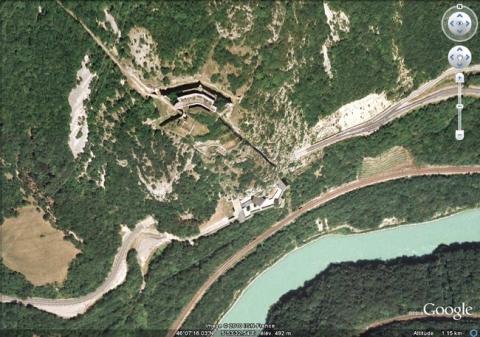Fort-l’Ecluse
History and description
Situated on a mountain above a bend of the Rhône, and populated since Gallo-Roman times, the fort l’Ecluse evolved from a stronghold created by the Lord of Gex in the 13th century. In 1293, it was ceded to the Savoy count Amédée V and became the subject of numerous power struggles from 1305 to 1601, whereupon it was finally given to France and renovated. In 1690, Vauban added an artillery battery.During the period 1721-1723, the military engineers of Louis XV constructed a first rampart there to ensure the Lyon-Genève road was included in the urban wall of the fort, allowing it to be cut off in the event of war. Between 1821 and 1830, it was reconstructed in the Restoration following its destruction during a siege in 1815. The July Monarchy completed the defensive installations with the construction of a fortified barracks, which was situated one hundred and fifty metres above the original fort. This barracks was constructed between 1831 and 1841 and was linked to the fort by a tunnel of stairs. The linking to Savoy in France in 1860 and the drilling of a road tunnel under the fort saw all interest in the site as the location of a fort lost.
Current state
The fort l’Ecluse still stands and has been restored since 1981. This restoration repaired the damage due to its 25 years of abandonment, following the downgrading of the barracks. The fort is open to visitors applying to the cultural affairs department of Léaz. Visits can be free, guided, thematic, at night, etc. The former road leading there has now become a hiking trail.
Fort-l’Ecluse
Fort-l’Ecluse
46° 7' 14.358" N, 5° 53' 33.6793" E
Type
fort
Engineers
Sébastien le Prestre de Vauban, François Nicolas Benoît Haxo
Department
Ain
Region
Auvergne-Rhône-Alpes
Bibliography
- BORNEQUE (R.), FAUCHERRE (N.), La route des fortifications dans les Alpes, Paris, 2006.
- BORNEQUE (R.), Vauban et les Alpes, Saint-Léger-Vauban, 1995.
- FAUCHERRE (N.), Places fortes, bastions du pouvoir, Paris, 2000, p. 68.
- LE HALLE (G.), Histoire des fortifications en Franche Comté et Pays de l’Ain, Amiens, 1991.
- WARMOES (I.), Le musée des Plans-Reliefs, Paris, 1997, p.46.
